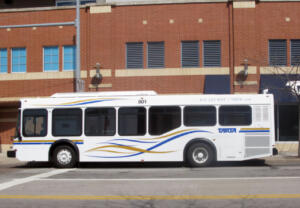After the pandemic prompted widespread adoption of a fare free model, we’re now seeing many transit agencies reverse course – with good reason.
As the fare collection partner to over 400 U.S. transit agencies, my Genfare colleagues and I have had a front row seat to agencies that have gone the zero-fare route. Although it was prompted by the pandemic, many decided to extend what was initially intended to be a temporary public health measure as a strategy for empowering equitable mobility.
Some agencies did see an increase in riders or trips taken once a fare free program was put in place. However, they also discovered serious downsides.
The costs of going fare free
As the history of fare free programs has shown since the 1970s, not all fare free experiments are successful. Public transportation advocates and scholars have been speaking out against free fares for years.
While it’s often believed free or reduced fares improve accessibility for low-income riders, cost may not be the biggest customer concern, according to TransitCenter. The group, which advocates for an increase in accessible public transportation options, surveyed 1,700 transit riders across seven U.S. cities. Respondents rated lower fares as less important than improved quality of service.
“This suggests that if a transit agency had to choose between devoting funds to reducing fares or to maintaining or improving service, most riders would prefer the latter,” the group reports.
We’ve seen time and time again that the problems that often spring up when agencies go fare-free make transit a less attractive choice to many riders.
“Some agencies who adopted universal free fares during the pandemic experienced an explosion of non-destination riders,” says my colleague Larry Chefalo, Genfare Business Development Director for the Central Region. “Safety, cleanliness, and quality of service complaints went up, deterring choice riders and making it more difficult to recruit transit operators.”
In addition, there can be considerable financial challenges associated with a fare free strategy. Suspending fare collection results in a revenue loss that has to be replaced somehow, whether it’s through grants or taxes. And it must be funded far into the future.
Plus, there’s the issue of perceived value: Paying a fare goes a long way toward increasing the perception that public transit is valuable.
At Genfare, we believe that a carefully designed fare collection solution can better address equitable transit goals, build public trust, and ensure rider and staff safety when compared to a zero-fare approach.

A post-pandemic turnaround

As Genfare customer Toledo Area Regional Transit Authority’s (TARTA’s) CEO Laura Koprowski found out, “Customers don’t need a free ride, they need a quality ride” at an affordable cost.
When TARTA reinstated fare collection, it resulted in increased customer accessibility, new riders, and the return of needed revenue. The agency had embraced the fare-free transit model on its buses during the pandemic. But the fare free model was not sustainable long term. Quality issues arose, including complaints about crime and uncleanliness on the buses. TARTA’s operating budget took a big hit.
TARTA changed course by reimagining a thoughtful new fare collection system, including new reduced fare programs for seniors, veterans, and students along with modernization of its antiquated token-based farebox technology. Genfare Fast Fare® fareboxes were installed on its 80 buses, configured to accept cash, coins, and magnetic fare media. TARTA also had Genfare update its garage data systems and vaults and integrate everything with the agency’s AVL and a third-party mobile ticketing app.
The changes were immediately apparent, Laura told us. “As soon as we brought fares back, our safety issues dropped quickly,” she says. “And the community has embraced the new fare system.”
Other agencies that began operating fare free pilots systemwide or on certain routes have decided to revisit or redeploy a fare collection strategy. In 2023, these included the Pinellas Suncoast Transit Authority, whose board voted to charge full fares on its beach transit shuttle from St. Petersburg, Florida. The same year, Rhode Island discontinued its fare free bus program in September, and Connecticut discontinued its zero-fare bus program in April.
Other agencies have encountered problems getting community support for reinstating fare payment, such as Kansas City, Missouri. In 2019, the city became the first to institute an entirely fare-free bus system. Surveyed riders said they were able to use the system more frequently and access jobs, food, and healthcare more easily. But the Kansas City Area Transportation Authority has struggled to continue funding the zero fare program, as reported by local NPR affiliate KCUR. A recommendation to reinstate collection was tabled after locals protested a return to paid fares.
Equitable fares allow reinvestment
 Genfare believes the most effective way to achieve equitable mobility isn’t to eliminate fares but rather to collect fares equitably to allow the agency to improve service. I’m finding that most of my clients have come to the same conclusion.
Genfare believes the most effective way to achieve equitable mobility isn’t to eliminate fares but rather to collect fares equitably to allow the agency to improve service. I’m finding that most of my clients have come to the same conclusion.
Since TARTA reinstated fare collection with new fareboxes, customers can board more quickly, and are happy with their new option to use cash or coin and to receive change in the form of a balance ticket. The new magnetic fare media option provides reduced fares for youth, seniors, veterans, and active-duty military, as well as 1, 7, and 31-day passes at full and reduced fares, helping keep TARTA service affordable and convenient for all. Ridership numbers have recovered as well.
At the same time, resuming fare collection results in vital revenue needed to invest in improvements, including paratransit and microtransit fleet expansion. In TARTA’s case, the agency not only met, but slightly exceeded its budgeted target for $1.8 million for fare collection in 2023.
TARTA worked hard to reintroduce the fares at a good value and conducted a community outreach campaign before the new fares were introduced. “Customers knew they’d had a good run” with fare free, Laura says.
In short order — only months after its fare collection upgrade — the agency was able to make good on its pledge to improve services to voters who had approved a sales tax funding model for TARTA in 2021.
Increasing accessibility
So how can transit agencies empower equitable mobility without giving free rides to everyone? Here are some time-tested recommendations:
● Continue to accept cash while also making it easy for unbanked and underbanked riders to digitize cash.
● Partner with organizations such as schools and social service agencies to administer free and reduced fare media to their students or clients.
● Require use of a smart card or other fare media for free and reduced fare riders so that data can be collected and analyzed.
● Target fare reduction initiatives to groups for whom fares are a significant burden such as essential workers or low-income riders.
● Put efforts into the service improvements riders have said are more important to them than price, including on-time performance and service frequency.
I invite you to reach out to me or your region’s Business Development Director to learn how you can leverage the latest fare collection technology.
Want to know more?
 Edward Brandis is Business Development Director for the Northeast region. Read more about Ed in our employee spotlight.
Edward Brandis is Business Development Director for the Northeast region. Read more about Ed in our employee spotlight.
To read more about TARTA’s experience reinstating fare collection, read our case study about the agency.
To learn more about the three pillars of equitable mobility, read our latest white paper or view our resource roundup on the topic.